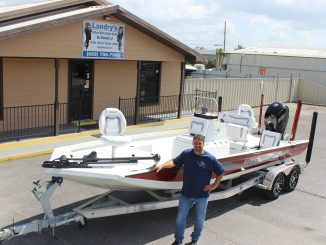
79-year-old thought he would never walk again
James Stelly stood up from his wheelchair and proudly stepped forward at the Cardiovascular Institute of the South (CIS) in Luling, a move that put a glow on the face of a man who thought he’d never do it again.
“I feel real good,” said the 79-year-old Sunset resident who pointed to the doctor who made it possible. “It couldn’t be better. This guy saved my life, because I didn’t know what I’d do. Don’t forget me, doc.”Stelly sincerely meant it.
Dr. Christopher Paris had come to his aid through a fortunate connection with CIS Cardiac Catheterization Lab Director Ryan Hebert, also in Luling. Stelly is one of nearly 12 million Americans who suffer from peripheral arterial disease (PAD), a hardening of the arteries due to build-up or blockage in his left leg.
These blockages keep extremities and organs from receiving oxygen-rich blood. And, just like clogged arteries in the heart, blocked arteries in the legs raises the risk of cardiovascular events, such as heart attacks and strokes. Ultimately, PAD can reduce mobility and be fatal if left untreated.
By the time Paris saw Stelly, his toes and leg were turning black and developing sores. He was confined to a chair. His daughter, Maureen, said all the doctors they’d seen told them in February the left leg had to be amputated. News of this devastated Stelly, who told her that he’d rather go home and die than lose a leg.
“I gave him a 20 to 30 percent chance he could open the flow,” said Paris, who pointed out that Stelly’s amputation was actually scheduled on the day he saw him. “If not, amputation was inevitable.”
Stelly’s situation was dire.
He had undergone numerous procedures on his legs over the past 10 years, but he was running out of options. Also, there was concern since higher mortality risks are associated with amputations.
A review of angiograms of Stelly’s legs showed he had complex disease, but Dr. Paris agreed to intervene. With cutting-edge technology and equipment, he went to work on arteries that had been closed for nearly three years.Paris used a chronic total occlusion crossing device, also called a crosser, to remove the blockage. Additionally, he used an artherectomy device, using a procedure he equated to a “Roto-Rooter” like plumbing process that helped clean out the disease.
From there, the doctor used drug-coated balloons, or stents, to reopen blood flow, technology that Paris said had only come available in the last year. Soon after, Stelly’s leg was ready for further treatment, and Paris reopened an artery in his lower leg using a collateral branch, which created a new passage for the blood.
“We used just about everything we had to open it up,” said Paris of the procedure done in July.
Paris performed interventional, non-surgical procedures to access Stelly’s arteries through his groin area, and the procedures took place in a cardiac catheterization lab at St. Charles Parish Hospital. The procedures, which took nine hours collectively, were a success.
Now, efforts focus on keeping the arteries functioning through medications.
“He’s doing a lot better than what we could have hoped for,” Paris said.
Stelly ended up with blood flow and color back in his foot, not to mention hope restored. Even though he needs a cane to walk, he can still ride his lawn mower and cut the grass.Paris also encouraged him to go shopping and do whatever he can manage.
Hebert said their work is really about improving quality of life. He added, “With advancements in technology to help treat these diseases, doctors can more aggressively treat conditions, resulting in better outcomes for our patients.”
The following symptoms can be indicators of PAD:
•Open ulcer/wound on the bottom of your foot that does not heal
• Feeling of pins and needles on the bottom of the foot that goes away with walking
• Stabbing pain in the ball of your foot that goes away with walking
• Severe cramping in your calf after walking or exercising that goes away immediately when stopping
Now, the man who initially came to CIS thinking he’d lose his leg, stood up and proudly displayed his new found ability to walk again. He then eagerly pulled off his sock to reveal a much healthier foot.
“That’s what it takes,” Stelly said of walking again. “Blood flow.”




Be the first to comment